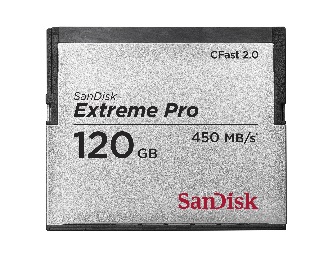
SanDisk has unveiled the world’s first CFast 2.0 memory card with its new Extreme Pro model that is available in 60GB and 120GB capacities.
The Extreme Pro CFast 2.0 just laid claim to the world’s fastest memory card, with read speeds of up to 450MB/s and write speeds up to 350MB/s, offering up to double the shot speed of today’s fastest cards.
The new CFast 2.0 card will launch along with the new ARRI AMIRA documentary-style camera, which is the first host system to use the CFast 2.0 standard. The SanDisk Extreme Pro CFast 2.0 will allow the ARRI AMIRA to record ProRes 4444 at up to 200fps. Additional ARRI ALEXA camera systems will be able to use the card with an available adapter.
In addition to support by ARRI, CFast 2.0 has Canon and Phase One on board as public supporters of the new format. As a result, we have a clear divide at the high end of the memory card spectrum.
Sony, Nikon and Lexar are locked into the new XQD format, while SanDisk, Canon, ARRI and Phase One are committed to CFast 2.0. Clearly, XQD has an early lead with the several cards from Sony and Lexar on the market, in addition to the new 4K Sony FDR-AX1 and Nikon D4‘s current use of the XQD format.
CFast 2.0 is a little late to the game with the first cards and camera coming soon. However, the CFast 2.0 format has some very impressive specs out of the gate with its 350MB/s write speeds (XQD is still well below 200MB/s for its max write speeds). CFast 2.0 makes big speed gains with its SATA-3 connection at 6Gbps (up to 600MB/s) max data throughput.
XQD cards use a PCIe interface with current max throughput at 2.5Gbps and the possibility of up to 5Gbps down the road. Accordingly, the theoretical maximum speeds tip the scale in favor of CFast 2.0.
The big bone for XQD and CFast 2.0 is 4K video data. The 4K standard is forcing its way into TV and film production and the data throughput requirements are only going to get bigger from here on out. These video standards are what will drive the write speeds of memory cards well beyond what SD and CF cards are capable of.
Photographers will, of course, benefit from these advances in card speeds down the road. However, we shouldn’t expect to see these high-speed cards in any cameras but the most advanced pro cameras for a while (e.g., the Nikon D4). Given the delivery of the CFast 2.0 card from SanDisk and ARRI’s use in its new camera, I wouldn’t be surprised to see Canon’s next 4K-capable EOS camera feature support for the CFast 2.0 memory cards – perhaps alongside a CF card slot with UDMA Mode 7 support.
One of the more intriguing aspects of this new memory card format war is that the XQD and CFast 2.0 standards both come out of the CompactFlash Association. Unlike the current competition between the CompactFlash Association and the SD Association with CF and SD cards, respectively, the two biggest next-gen memory card specifications are created by the same entity – with different manufacturers backing each specification. Even stranger, the two major memory card producers (Lexar and SanDisk) are currently only backing one side of this rather odd format war.
Is this HD-DVD vs. Blu-ray for the photo and video production world? Is the room for the SD Association to move in with a competitor to challenge the CompactFlash Association’s cornering of the high-end market? What is Lexar and SanDisk’s motivation for taking a single side in the next-gen memory card platforms – particularly when the come from the same standards association? These are questions we’ll look forward to answering in the coming format war.
As for now, pricing and specific availability info is not yet available for the new SanDisk Extreme Pro CFast 2.0 card. Export more commentary from yours truly when it becomes available.


Jeez…. my hard drive is slower than that!